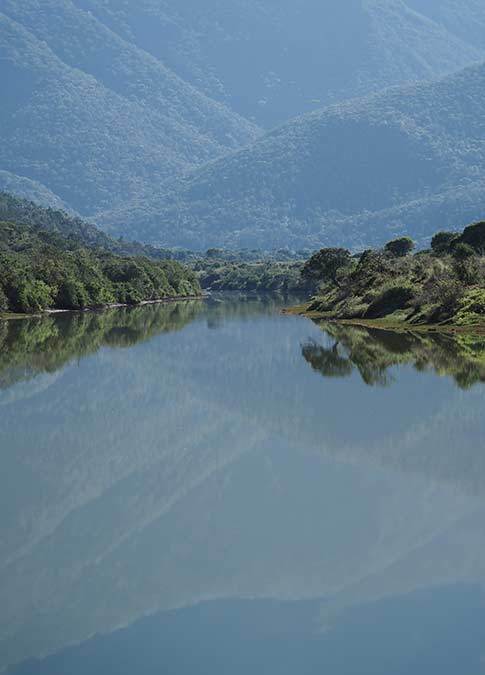Spring
Everywhere one goes young animals are to be seen, and the talk at lunch-time centres around the lioness and her cubs and whether or not they have been seen during the morning. Beside the road to River Lodge a Cape Spotted Eagle Owl has a nest almost at eye-level with those sitting at the back of the Landcruiser. She surveys the world while sitting on eggs. Spring is very much in the air it seems, yet apart from the birds and animals there are, for those accustomed to a European spring, or even that season in other parts of South Africa, few obvious signs of spring. Where are all the flowers of the spring bulbs? Where are the delicate, pale green new leaves?
A vast area of the park is covered in what an early European traveller chose to describe as “a great, grey, thorny and spine-clad impenetrable jungle with a uniformity of colour unaltered by the changing seasons”. This is the sub-tropical thicket, or valley bushveld, a plant community that is found in patches for 800 kilometres along the Cape south-east coast, from Calitzdorp in the Western Cape to the Great Fish River in the east. The early settlers regarded it as waste ground and set about clearing as much as they could in order to plant crops or provide grazing for their stock. When heavy earth-moving equipment became available the rate of clearing increased appreciably, and it is estimated that at least 800 000 hectares of land once covered by thicket is now degraded.
Despite the early traveller's remark regarding the uniformity of colour and apparent lack of seasonal change in the thicket, changes do occur. Even the spring bulbs produce their bright, striking flowers, but one does have to look carefully for them. Tucked away under bush only centimetres off the road from Ukhozi Lodge, and not far from the restaurant of the Main Lodge, we spied the green strap-like leaves and bright red nodding blossoms, tinged with yellow and green of the Eastern Cape clivia, Clivia nobilis, a sure sign that the worst of the winter weather was over.
Immediately outside and standing in the middle of the walkway up to the restaurant, the Portulacaria affra was covered in a pale purple haze of blossom. This small tree is commonly known as spekboom – bacon tree – or oliphantskos – elephants' food – and both names give some idea of its high food value and popularity amongst the browsers. And elephants in particular are indeed extremely fond of the plant.
Spekboom is the “superplant” of the sub-tropical thicket, for apart from its food value it is an important weapon in the fight to moderate climate change. It has the ability to photosynthesize CO2 in excess of 20kg per square metre, which rivals even the trees of the tropical forests, yet it grows in areas of comparative low rainfall of between 250 mm and 350 mm per annum. The UN Clean Development Mechanism carbon trading system allows companies and governments in the developed world to buy carbon credits in the developing world to offset carbon pollution, a ton of CO2 being worth between R100 and R200, which means that farmers may soon find it very profitable to cultivate spekboom, the plant their ancestors tried to eradicate. It is estimated that the market in Europe alone is presently worth between R100-billion and R200-billion a year. Meanwhile the spekboom at Kariega continues to do its bit to lessen the extremes of climate change.









